Recipes
Garlic Scape Pesto / Pistou
The scapes are harvested in early summer when they begin appearing at the markets, and adding them to basil pesto is a brilliant way to use them. This recipe combines fresh basil and garlic scapes along with pine nuts, Parmesan cheese, and olive oil. It takes just a few minutes to whip up in a food processor, creating a sauce with a vibrant garlicky-herb flavor.
Tested by Colleen Graham 07/29/2021
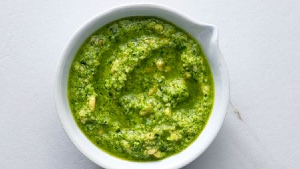
Prep: 15 mins
Cook: 0 mins
Total: 15 mins
Servings: 8 servings
Yield: 1 cup
Nutrition Facts (per serving)
361 Calories
36g Fat
6g Carbs
5g Protein
Garlic scapes are the long and curly, tender stems that grow from the center of hard-necked garlic. This type of garlic is the one most commonly grown in North America, and the scapes need to be removed so the garlic bulb can grow larger before harvest. Scapes are an early-season gift for garlic lovers, with a flavor of onions, garlic, and scallions—an ideal three-in-one addition for savory recipes. Once you try scapes, they will become a new favorite allium.
The scapes are harvested in early summer when they begin appearing at the markets, and adding them to basil pesto is a brilliant way to use them. This recipe combines fresh basil and garlic scapes along with pine nuts, Parmesan cheese, and olive oil. It takes just a few minutes to whip up in a food processor, creating a sauce with a vibrant garlicky-herb flavor.
Toss the garlic scape and basil pesto with pasta or use it to top potatoes, rice, salads, chicken, beef, pork, or slices of mozzarella di buffalla. This pesto doesn’t brown as fast as regular pesto, and it freezes beautifully so you can enjoy it throughout the year.
“The pesto is easy to whip up, and I appreciate the recommendations for making it to taste. I prefer less oil in pesto and had about 1/4 cup left over. The taste was perfect: a great garlic flavor against fresh sweet basil, and those semi-crunchy pine nuts and Parmesan…It’s just waiting for pasta!” —Colleen Graham
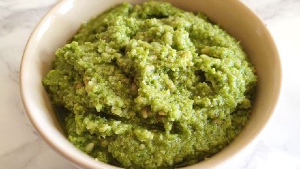
Ingredients
12 large garlic scapes, bulb removed, cut into 1/2-inch pieces (about 1/2 cup)
1 cup loosely packed fresh basil leaves
1/2 teaspoon kosher salt
1 cup extra-virgin olive oil , divided and to taste
1 cup grated Parmesan cheese, divided and to taste
1/2 cup pine nuts , or walnuts
Steps to Make It
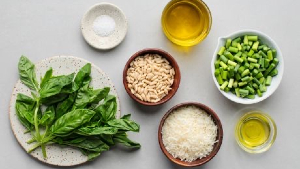
Add the garlic scapes, basil, and kosher salt to a food processor or blender.
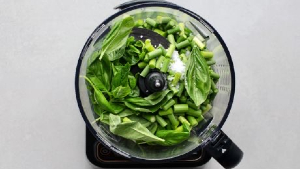
Pulse a couple of times to achieve a rough mixture.

Slowly start adding 1/2 cup of the olive oil.
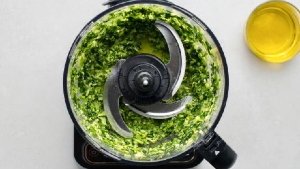
Stop processing and scrape down the sides of the bowl with a rubber spatula.
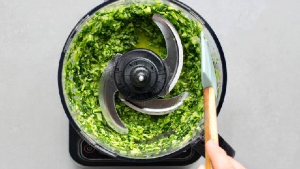
The texture of the final pesto is up to personal taste. If the sauce seems too thick for your preference, add 2 tablespoons of olive oil at a time and check again for your ideal consistency.
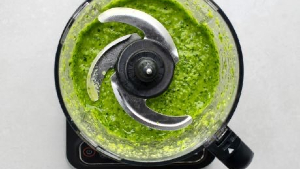
Once a smooth paste has been achieved, add 1/2 cup of the Parmesan cheese and process until completely mixed in. Taste for seasonings.
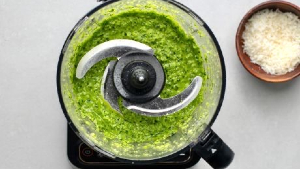
Add the remaining cheese if you’d like a thicker and more savory paste, or leave as is if you’re happy with the flavor and consistency so far.
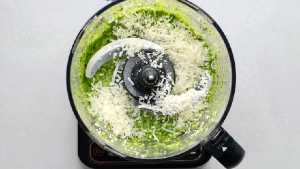
Add the pine nuts and process at low speed until the nuts are roughly chopped and fully mixed in. The coarse nuts give the pesto a great texture.

Place the pesto in a serving bowl and refrigerate until ready to use. Top with a thin layer of olive oil and place in an airtight container if you’re not consuming it right away.
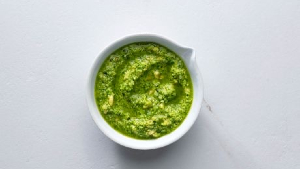
Recipe Variations
Chopped walnuts are a good substitute for pine nuts.
Add one chopped avocado to the food processor to put a garlic scape twist on avocado pesto.
Substitute the basil with another fresh herb or mix of herbs, such as parsley, cilantro, or dill.
How to Store and Freeze
Store the garlic scape pesto in an airtight container. Refrigerated, it will keep for about six to seven days.
To freeze, spoon the pesto into an ice cube tray or large muffin tin and place it in the freezer. Once frozen, transfer to a freezer-safe bag or container; the pesto will be good for at least six months.
What Parts of Garlic Scapes Are Edible?
You can eat the entire garlic scape raw or cooked. The best and most tender part is below the bulb ( umbel ) that forms in the middle of the scape. Similar to onions, if left on the garlic plant, this scape bulb would flower out and produce tiny garlic seeds (mature garlic cloves produce better garlic bulbs). The scape above the bulb ( the beak ) can be tough and is not a good choice for a no-cook recipe like pesto. If you want to save the pointy ends, add them to a stir-fry or garlic scape soup where they’ll get cooked until tender.

